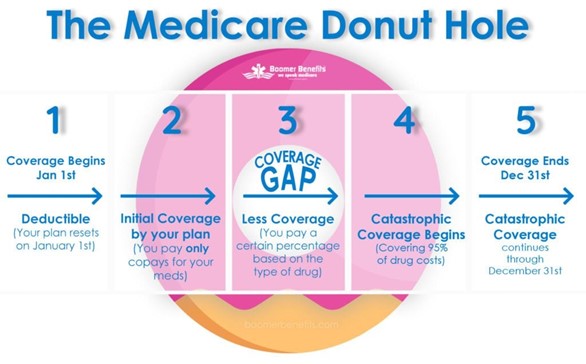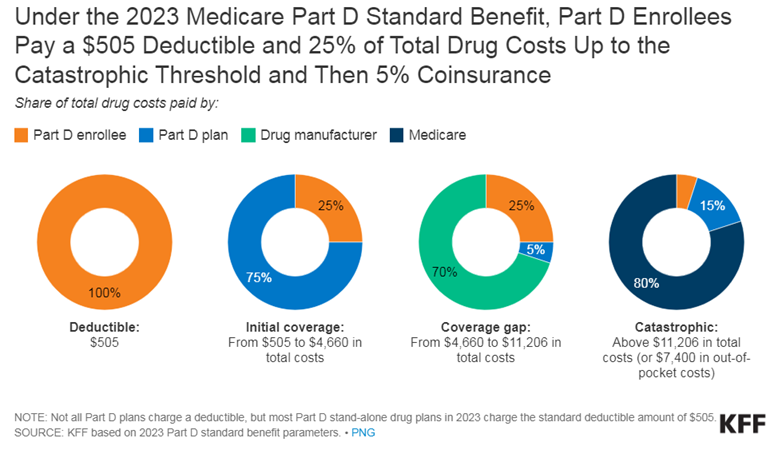Changes to Medicare Part D Coverage Gap
The Inflation Reduction Act of 2022 includes several provisions to lower prescription drug costs for people with Medicare and several changes to the Medicare Part D drug benefit. This brief provides an overview of these changes in 2023, and how the federal government is working to close the Medicare Donut Hole with more changes in the future.
WHAT IS THE MEDICARE DONUT HOLE?
The Donut Hole is a term used for the Medicare Part D coverage gap. All Part D plans have a gap, or a “hole” in the middle of your drug coverage during a calendar year. After your initial coverage period, you enter the donut hole when your total drug costs reach the limit of $4,660 (this is the threshold amount for 2023 and may change each year). While in the coverage gap, there’s a temporary limit on what your plan will cover for drugs, both brand-name and generic. To exit the donut hole, your out-of-pocket costs much reach $7,400. This is when catastrophic coverage begins, and you’ll pay 5% of the drug costs until the end of the year. See Figure 1 for an outline of the Medicare donut hole.
Can You Avoid the Donut Hole?
Do your best to stay below the threshold amount by keeping track of how much you’ve spent on medications throughout the year. Work with your doctor on reducing your drug spending and take generic medications or drug alternatives whenever possible.
What Does the 2023 Medicare Part D Drug Benefit Look Like?
The Medicare Part D benefit has four phases, where the share of drug costs paid by Part D enrollees, Part D plans, drug manufacturers, and Medicare varies (Figure 2).
IS THE MEDICARE DONUT HOLE CLOSING?
The donut hole (or coverage gap phase) has been slowly closing since 2010, when the Affordable Care Act was passed. In the past, you would pay 100% of the drug costs when you were in the coverage gap. But as of this year, you are responsible for a much lower percentage. In 2023, you pay 25% of your prescription costs during the Medicare donut hole. This means that drug manufacturers are required to provide a 70% price discount on the total costs of your medications, and your plan pays the other 5%.
Further efforts to decrease the impact of the Medicare Part D coverage gap include:
- More recommended vaccines (such as Shingles, Tetanus/Diphtheria, Whopping Cough, Hepatitis A, Hepatitis B, Flu, COVID-19, and Pneumococcal Pneumonia) are now covered for free under Medicare Part D, with no cost sharing.
- Lower out-of-pocket costs for insulin products, no more than $35 per month in all Part D plans.
- Lower out-of-pocket costs for 43 prescription drugs. Some people with Medicare who take these drugs may save between $1 and $499 per average dose in 2023. Medicare will also negotiate to get you lower drug prices on certain brand-name Medicare Part B and Part D drugs.
And there are more changes coming. By 2025, the donut hole will be eliminated, meaning that Part D enrollees will no longer face a change in their cost sharing when they move from the initial coverage phase to the coverage gap phase.
SOURCES:
- Medicare Interactive – https://www.medicareinteractive.org/get-answers/medicare-prescription-drug-coverage-part-d/medicare-part-d-costs/the-part-d-donut-hole
- Medicare.gov – https://www.medicare.gov/drug-coverage-part-d/costs-for-medicare-drug-coverage/costs-in-the-coverage-gap
- Boomer Benefits – https://boomerbenefits.com/medicare-part-d-plans/medicare-donut-hole-2023/
- KFF – https://www.kff.org/medicare/issue-brief/changes-to-medicare-part-d-in-2024-and-2025-under-the-inflation-reduction-act-and-how-enrollees-will-benefit/
- Centers for Medicare & Medicaid Services – https://cms.gov/newsroom



